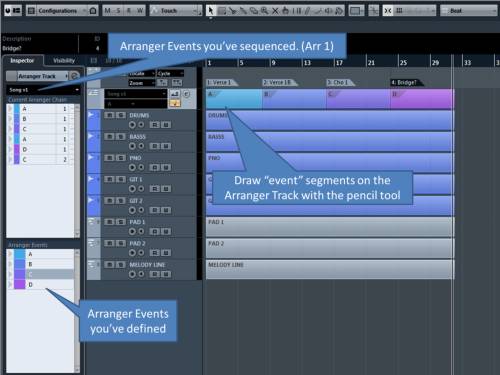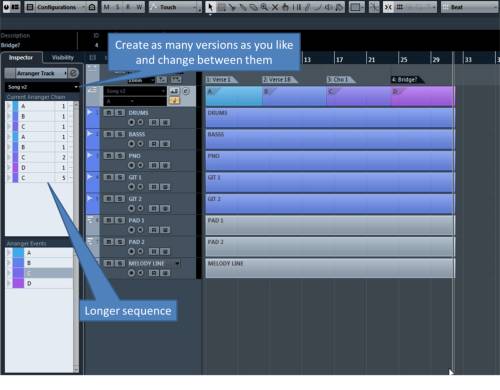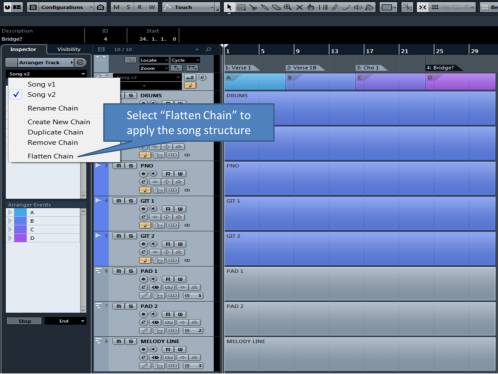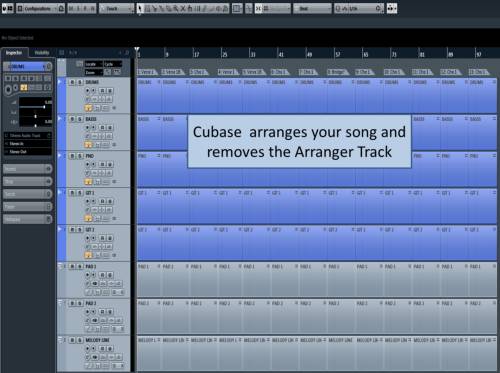Songwriting Tricks with Cubase's Arranger Track
This is a guest article by Eric Block, a songwriting hobbyist, owner and operator of CubaseTutor.com.
You can hear some of his songs on his Reverbnation site.
When I’m writing a song, I always try out many different versions of verses, choruses and bridges and then experiment with stringing them together in different combinations.
This would be difficult if I had to keep copying, pasting and editing sections.
Fortunately, Cubase offers a feature called, “Arranger Track” that lets me draw segments or “Arranger Events” on my project timeline.
Most DAWs provide similar capabilities.
I can draw as many Arranger Events as I like and they can be any size I need them to be.

So I can draw separate ones for each version of the verse, chorus, bridge, etc.
Once I do that, I can play any of them in any order I wish simply by “chaining” them together in various combinations.
I can create as many chains as I like too and switch between them instantly until the song flows exactly the way I want it to.

Once I’m satisfied, I use the “Flatten” command to have Cubase copy and sequence the events to match the sequence in my Arranger Chain.
All of the unused segments are eliminated.

I wind up with a clean arrangement exactly as I defined it.
Now, I can continue developing the arrangement by modifying and developing each section however I want to.
I can even repeat the whole process again.
It’s really cool.

Wait... there's more!
But there’s another way to use the Arranger Track that’s also quite useful whether you've finalized the main sequence of song parts or not.
That is to create short Arranger Events to try out different transitions between these song parts.
Say your song has the following structure:
Arranger Event A: Intro
Arranger Event B: Verse 1 and 2
Arranger Event C: Chorus 1 and 2
Arranger Event B: Guitar solo
Arranger Event D: Bridge
Arranger Event C: Chorus 3 (reprise and fade)
Maybe you want the drums to kick up a notch during the first two measures of Chorus 1 and 2 but not during the first two measures of Chorus 3, especially since the same intro fill would keep repeating during the fade.
Problem is: Segment C is currently handling all three choruses.
Start by drawing a new arranger event “E” that starts two measures into Segment C.
Now copy all of the parts in those first two measures to a new location on the project timeline.
Use the Scissors tool to slice across all of the tracks at the beginning and end points using the appropriate Snap function to make sure you get the desired results.
Now draw a new Arranger Event for the two measures you’ve just copied.
Let’s call it Event “F.”
Last step: Modify your Arranger Chain for the final chorus by replacing Chorus 3's Event C with Events E & F.
Now you can start modifying the drums in Segment E until you’re completely satisfied with the new transition.
When you’re done, simply use Flatten on those sections and the arrangement will become reality.
Piece of Cake!

I do a lot of this kind of thing when I’m writing a song.
I’ll try out different versions of each part, the transitions between them, etc.
Sometimes, it’s better to use “Track Versions” for this, a Cubase feature that lets you create alternate versions of individual or groups of tracks and then recall them at will.
As always, it depends on what you're trying to accomplish.
If you’d like more tips on songwriting with Cubase, please contact me at www.CubaseTutor.com or “Like” my Cubase OneOnOne Online Tutoring page on Facebook here.









